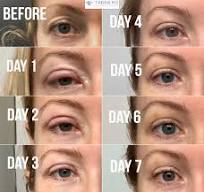
Enhance Your Look with Eyelid Surgery (Blepharoplasty)
The Complete Guide to Eyelid Surgery (Blepharoplasty)
Eyelid surgery, also known as blepharoplasty, is a cosmetic procedure that aims to improve the appearance of the eyelids. This surgical technique can address various concerns such as drooping eyelids, puffiness, and excess skin around the eyes.
There are two main types of blepharoplasty: upper eyelid surgery and lower eyelid surgery. Upper eyelid surgery focuses on removing excess skin and fat from the upper eyelids, while lower eyelid surgery targets under-eye bags and puffiness.
Patients opt for blepharoplasty for both aesthetic and functional reasons. In addition to rejuvenating the appearance of the eyes, eyelid surgery can also improve vision by lifting drooping eyelids that obstruct the field of vision.
The blepharoplasty procedure typically involves making incisions along the natural creases of the eyelids to minimize visible scarring. The surgeon then removes or redistributes excess fat, skin, and muscle tissue to achieve a more youthful and refreshed look.
Recovery from eyelid surgery varies from patient to patient but generally involves some swelling, bruising, and discomfort in the first few days. Patients are advised to follow post-operative care instructions carefully to promote healing and minimize complications.
It is essential to consult with a board-certified plastic surgeon or oculoplastic specialist before undergoing blepharoplasty to discuss expectations, risks, and potential outcomes. A thorough evaluation will help determine if you are a suitable candidate for eyelid surgery.
Overall, blepharoplasty is a safe and effective way to enhance the appearance of the eyes and achieve a more youthful look. With advancements in surgical techniques and technology, patients can benefit from natural-looking results that restore confidence and vitality.
Essential Tips for a Successful Eyelid Surgery: What to Know Before and After Blepharoplasty
- Ensure you are a good candidate for blepharoplasty by consulting with a qualified surgeon.
- Discuss your goals and expectations with the surgeon during the consultation.
- Follow all pre-operative instructions provided by your surgeon to prepare for the surgery.
- Be prepared for some swelling and bruising post-surgery, and follow post-operative care guidelines.
- Avoid strenuous activities that may strain your eyes during the recovery period.
- Attend all follow-up appointments with your surgeon to monitor healing progress.
Ensure you are a good candidate for blepharoplasty by consulting with a qualified surgeon.
To ensure the success and safety of your blepharoplasty procedure, it is crucial to consult with a qualified surgeon to determine if you are a suitable candidate for eyelid surgery. A board-certified plastic surgeon or oculoplastic specialist can assess your individual needs, expectations, and medical history to provide personalized recommendations. By seeking professional guidance before undergoing blepharoplasty, you can make informed decisions about your eye rejuvenation journey and achieve optimal results tailored to your unique facial anatomy and aesthetic goals.
Discuss your goals and expectations with the surgeon during the consultation.
During the consultation for eyelid surgery (blepharoplasty), it is crucial to openly discuss your goals and expectations with the surgeon. By clearly communicating what you hope to achieve through the procedure, you can ensure that the surgeon understands your vision and can provide personalized recommendations tailored to your needs. This dialogue not only helps set realistic expectations but also fosters a collaborative relationship between you and the surgeon, ultimately leading to a more satisfying outcome. Transparency and clarity in discussing your goals during the consultation are key steps in embarking on a successful blepharoplasty journey.
Follow all pre-operative instructions provided by your surgeon to prepare for the surgery.
It is crucial to adhere to all pre-operative instructions provided by your surgeon to prepare effectively for eyelid surgery (blepharoplasty). Following these guidelines meticulously can help optimize the surgical outcome and minimize any potential risks or complications. From dietary restrictions to medication adjustments, each instruction is designed to ensure that you are in the best possible condition for the procedure. By following your surgeon’s recommendations closely, you can contribute to a smooth and successful surgical experience, setting the stage for a seamless recovery and optimal results.
Be prepared for some swelling and bruising post-surgery, and follow post-operative care guidelines.
After undergoing eyelid surgery, also known as blepharoplasty, it is crucial to be prepared for some swelling and bruising in the days following the procedure. These common side effects are a natural part of the healing process and typically subside over time. To promote optimal healing and reduce discomfort, it is essential to follow post-operative care guidelines provided by your surgeon diligently. By adhering to these instructions, such as applying cold compresses, taking prescribed medications, and avoiding strenuous activities, you can help minimize swelling and bruising while supporting a smooth recovery process.
Avoid strenuous activities that may strain your eyes during the recovery period.
During the recovery period after eyelid surgery (blepharoplasty), it is crucial to avoid strenuous activities that may strain your eyes. Engaging in activities that put undue pressure on the eyes can hinder the healing process and potentially lead to complications. It is recommended to rest and allow your eyes to recover without subjecting them to excessive strain, ensuring a smoother and more successful recovery from the surgery.
Attend all follow-up appointments with your surgeon to monitor healing progress.
Attending all follow-up appointments with your surgeon is crucial in monitoring the progress of your healing after eyelid surgery (blepharoplasty). These appointments allow your surgeon to assess your recovery, address any concerns, and ensure that you are healing properly. By following through with scheduled follow-up visits, you can receive personalized care and guidance to optimize the results of your eyelid surgery and achieve the best possible outcome.

